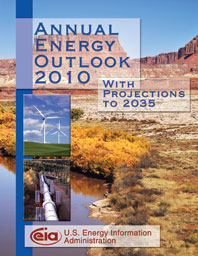Over the next 25 years, energy consumption is expected to grow, but there will also be a greater use of renewable fuels within the transportation sector, according to the U.S. Energy Information Administration. In its Annual  Energy Outlook 2010, the EIA analyzed energy trends that will shape the U.S. between now and 2035.
Energy Outlook 2010, the EIA analyzed energy trends that will shape the U.S. between now and 2035.
The reference case assumes that the production tax credit (PTC) for electricity generation from renewable energy sunsets in 2012 (wind) or 2013 (other technologies) as specified in current law, but “it has a history of being renewed and could be extended again,” it adds.
In the reference case, renewable generation accounts for 45% of the increase in total generation from 2008 to 2035 while, in alternative cases which assume the PTC is extended through 2035, “the share of growth in total generation accounted for by renewables is between 61 and 65%.”
Renewable energy to supply 14% by 2035
The renewable share of total energy use increases from 8% in 2008 to 14% in 2035, in response to the RFS, expansion of federal tax credits for renewable electricity generation and capacity, and state RPS programs, the report notes.
Natural gas consumption will grow by 0.2% per year despite declines until 2014 when coal-fired power plants now under construction begin operation.
More than half of US states have either binding RPS or non-binding voluntary targets for renewable energy generation, and the recent enactment of federal tax credits for distributed renewable technologies through 2016 “provides the greater assurance necessary for market development that will help states achieve their renewable energy goals.”
Outlook examines renewable energy technologies
Total installed solar photovoltaic (PV) capacity will reach 9.5 GW by 2035 in the reference case, but could grow to 60.5 GW in the extended policies case. The distributed wind turbine market is similarly affected, with 8.1 GW installed under the extended policies case compared with 1.7 GW in the reference case by 2035.
In the reference case, implementation of current incentives for geothermal heat pumps increases the number of installations from 47,000 units in 2008 to an average of 150,000 per year through 2016, when the federal tax credit expires.
Even with the increase in installations, the market share of ground-source heat pumps is only 2.3% in 2035 in the reference case, up from 0.3% in 2008. In the extended policies case (with the tax credit extended through 2035), the market share doubles to 4% in 2035.
“The extension of tax credits for renewables through 2035 would lead to more rapid growth in renewable generation than projected in the reference case, particularly over the longer run,” it explains. “When the renewable tax credits are extended without extending energy efficiency standards, as is assumed in the No Sunset case, there is significant growth in renewable generation throughout the projection period relative to the reference case projection.”
“Extending both renewable tax credits and energy efficiency standards results in more modest growth in renewable generation, because renewable generation in the near term is the primary source of new generation to meet load growth, and enhanced energy efficiency standards tend to reduce overall electricity consumption and the need for new generation resources.”
Fossil fuels lose share
Although fossil fuels continue to provide most of the energy consumed in the USA over the next 25 years in the reference case, their share of overall energy use falls from 84% in 2008 to 78% in 2035.
The Annual Energy Outlook presents a projection and analysis of US energy supply, demand and prices through 2035, and includes 38 sensitivity cases which explore areas of market, technological, and policy uncertainty in the energy economy.
http://www.eia.doe.gov/oiaf/aeo/index.html
1 Comments
Geothermal Heat Pump
Can you provide me with more information?